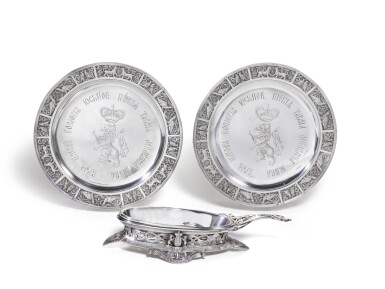
Property from a Washington D.C. Private Collection
THE YUSUPOV SCANDINAVIAN SERVICE: A PAIR OF FRENCH SILVER PLATES AND A SILVER SERVING DISH, ALEXANDRE GUEYTON, PARIS, 1842-63
Lot Closed
June 17, 03:48 PM GMT
Estimate
4,000 - 6,000 GBP
Lot Details
Description
Property from a Washington D.C. Private Collection
THE YUSUPOV SCANDINAVIAN SERVICE: A PAIR OF FRENCH SILVER PLATES AND A SILVER SERVING DISH, ALEXANDRE GUEYTON, PARIS, 1842-63
the plates engraved with a crowned lion salient, with an inscription in Russian ‘Prince Nikolay Borisovitch Yusupov / Princess Alexeevna Yusupova’, the borders repoussé with birds and lions; the serving dish with open strapwork handle decorated with a Scandinavian-style ornament, the body with the Yusupov coat-of-arms, both struck Gueyton, with later Russian import marks for St Petersburg
(3)
length of dish over handle28.7cm, 11⅜in.
diameter of plates 25.3cm, 9⅞in.
Please note: Condition 11 of the Conditions of Business for Buyers (Online Only) is not applicable to this lot.
To view Shipping Calculator, please click here
Prince Nicholas Borisovitch Yusupov and his wife Tatiana de Ribeaupierre, to their daughter
Princess Zinaida Nicolaevna Yusupov and her husband, Count Felix Sumakarov-Elston
Acquired by Edward C. Finch in Russia (then the Russian Soviet Federative Socialist Republic) in 1927
Thence by descent
The Yusupov service, also called the 'Scandinavian' service, was commissioned in Paris for Prince Nicholas Borissovich Youssoupov (1827-1891) and his wife Countess Tatiana de Ribeaupierre (1828-1879); their names appear on the dinner plates for the service (examples sold Christie's, New York, April 18, 2007, lot 249). Import marks show that the service entered Russia in the late 19th century.
The Scandinavian Service of the Yusupov Family, included many impressive pieces that share the design of these plates and serving dish. Notably the Hermitage Collection includes an impressive tureen on stand (Э-11894) and silver-mounted glass centrepiece (Э-11892), both of which entered the collection in 1922-23.
An impressive Scandinavian Service tureen from the same collection as the present lot was sold Sotheby's New York, 20 May 2004, lot 163. Part of the flatware service was given to the Taft Museum, Cincinnati, then offered Christie's, New York, October 21, 2003, lot 135. A double salt was sold Sotheby's, Sydney, August 29, 2006, lot 280.
These pieces from the Scandinavian service are part of a rare and historic collection of silver from the private collection of Prince Felix Yusupov and his wife, Princess Irina Alexandrovna, which appears on the market for the first time since it was acquired by Edward C. Finch in Russia in 1927.
Princess Zinaida Nicolaevna Yusupov and Count Felix Sumakarov-Elston
An aristocrat and husband to Emperor Nicholas II’s niece, Prince Felix is perhaps best known for his participation in the assassination of Rasputin. Richer even than the Romanovs, the Yusupov family amassed their fortune over many generations. Their fortune included four palaces in Saint Petersburg, three palaces in Moscow, thirty-seven estates throughout Russia, coal and iron-ore mines, plants and factories, mills and oil fields on the Caspian Sea. Forced into exile following the Emperor’s abdication, Felix and Irina fled Russia with very few of their possessions.
Hidden Treasure
Before fleeing in autumn 1917, Prince Felix Yusupov sought to conceal a portion of his family's treasures from the Revolutionaries. Jewellery and art objects, including pieces from the Yusupov Scandinavian service like the present lot, were walled up under a staircase of the Yusupov's Moscow house, a former hunting lodge of Ivan the Terrible (see Prince Felix Yusupov, Lost Splendor, New York, 2014, p. 277). The Bolsheviks occupied most of the Yusupov’s properties, including the mansion in central Moscow. It was not until 1925 during repairs to the building that a secret storage, containing jewellery, gold and silver, was found under the staircase.
The Soviet government held a very pragmatic view of Imperial treasures, selling them abroad or even melting them down. Thankfully, some of this group was salvaged in September 1927, when a wealthy American traveller Edward C. Finch bought it from a Soviet shop to benefit Russian children. It was during his travels in Russia that Edwards C. Finch also collected the present group of porcelain from the Cottage Palace Service.
This group of treasures travelled to the United States, where it remained in Edward C. Finch’s private family collection ever since.
Edward C. Finch
Edward Corwin Finch (1862 – 1933) was an American businessman, real estate developer and philanthropist in the state of Washington. He served in the Washington State Senate from 1927 to 1931 and travelled to Russia while on honeymoon with his second wife.
